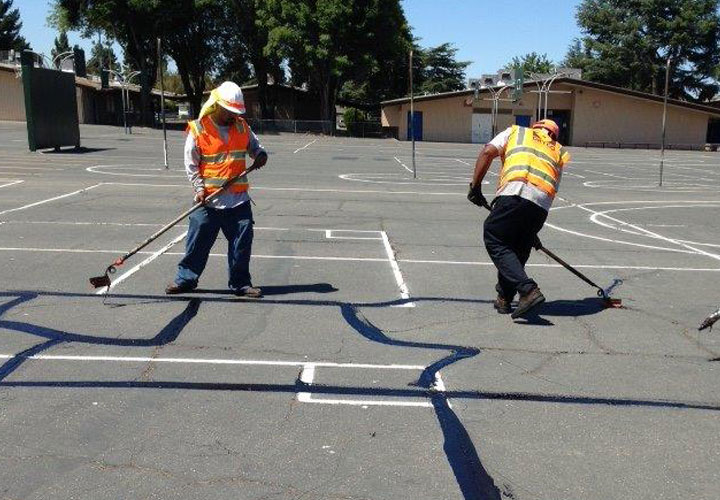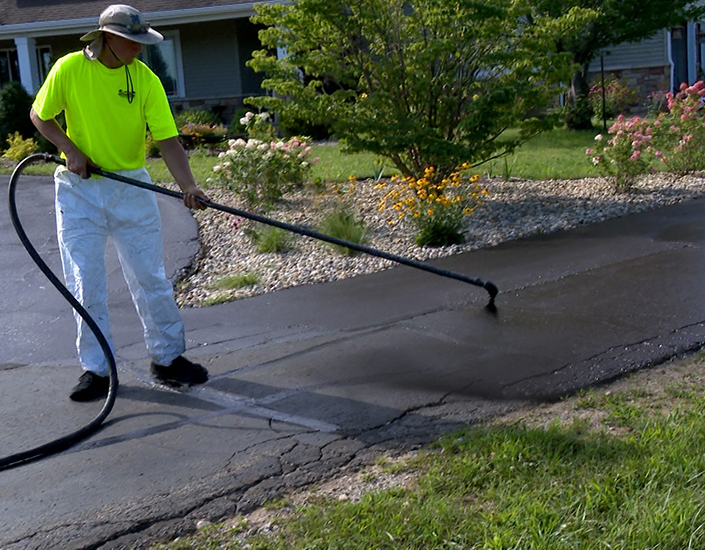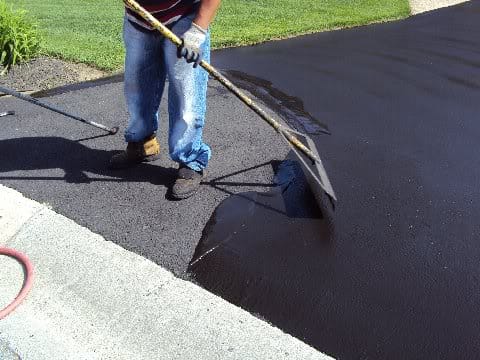Boost Commercial Appeal: Hot Mix Asphalt Sealing for Angled Parking Lots
Boost Commercial Appeal: Hot Mix Asphalt Sealing for Angled Parking Lots
Blog Article
Hot Mix Asphalt: A Sustainable Solution for Sidewalk
Warm Mix Asphalt (HMA) has actually emerged as a leading lasting option for pavement solutions, supplying a myriad of environmental advantages and innovative innovations. Its ability to recycle products and minimize energy intake presents an engaging case for its fostering in road building tasks. In addition, the lasting performance and sturdiness of HMA make it a preferred option for infrastructure growth. As the demand for environmentally friendly building and construction methods grows, checking out the subtleties of HMA's sustainability can provide useful insights into the future of pavement services.
Ecological Advantages of Warm Mix Asphalt

Moreover, Hot Mix Asphalt helps to minimize urban heat island impacts. Its dark shade absorbs sunlight, reducing the amount of heat showed back right into the ambience contrasted to lighter-colored sidewalks. This can reduce ambient temperatures in city locations, lowering the need for air conditioning and inevitably minimizing power usage.
On top of that, Hot Mix Asphalt adds to improved stormwater administration. Its porous nature allows water to infiltrate the pavement and charge groundwater supplies, decreasing overflow and the danger of flooding. These ecological advantages make Warm Mix Asphalt a lasting option for leading roadways and highways.
Power Performance in HMA Production
Is energy efficiency an essential consider the manufacturing of Hot Mix Asphalt (HMA)? Definitely. Power plays a substantial duty in the manufacturing of HMA, impacting both expense and ecological sustainability. One crucial facet of power effectiveness in HMA production is making use of warm mix asphalt (WMA) technologies (commercial parking lot paving). WMA permits the mixing and positioning of asphalt at lower temperatures compared to traditional hot mix asphalt, resulting in minimized power usage during production. This process not only decreases gas use yet additionally reduces greenhouse gas discharges, making it a more eco-friendly option.
Moreover, advancements in plant technologies have actually brought about more energy-efficient HMA manufacturing procedures. Modern plants are designed with features like recycled asphalt sidewalk (RAP) handling capabilities, efficient burner systems, and boosted insulation, all adding to energy savings. By optimizing power usage in HMA production, the industry can lower its carbon footprint while keeping high-grade pavement products. Energy effectiveness is, for that reason, a crucial factor to consider in ensuring the sustainability of Hot Mix Asphalt manufacturing.
Recyclability of Hot Mix Asphalt
The recyclability of Hot Mix Asphalt (HMA) is an essential aspect of its sustainability and long-lasting ecological influence. HMA is one of the most recycled materials in the USA, with over 100 million loads of redeemed asphalt sidewalk (RAP) being reused yearly in brand-new sidewalk building. Recycling HMA supplies numerous environmental advantages, such as reducing the demand for virgin materials, lowering energy usage throughout manufacturing, and reducing the quantity of waste sent out to land fills.
The procedure of reusing HMA involves grating the existing sidewalk, squashing it into smaller sized items, and blending it with brand-new aggregate and asphalt binder to create a recycled mix. This recycled mix can frequently perform in addition to and even much better than traditional HMA, while calling for less basic materials and producing lower greenhouse gas discharges. By including RAP into brand-new sidewalk tasks, roadway agencies can save all-natural sources, minimize prices, and lessen the environmental footprint of road building and construction and maintenance activities. Generally, the recyclability of HMA plays a significant role in advertising lasting methods within the sidewalk industry.

Long-Term Efficiency of HMA
Asphalt pavements demonstrate resilience and durability over a prolonged period, showing the long-lasting efficiency of Hot Mix Asphalt (HMA) The durability of HMA can be credited to its ability to stand up to rush hour lots, rough climate condition, and the results of aging. Studies have shown that properly designed and properly built HMA pavements can last for twenty years or more with routine maintenance. The secret to maximizing the lasting efficiency of HMA exists in using high-quality products, adhering to best practices in building, and executing efficient maintenance strategies. Correct drainage, routine inspections, and prompt repair services are vital for protecting the architectural integrity of HMA pavements over time. In addition, improvements in HMA innovation, such as making use of polymer-modified binders and warm mix asphalt, have actually additionally boosted the longevity and longevity of HMA sidewalks. By prioritizing high quality building and construction and maintenance methods, HMA continues to confirm itself as a economical and lasting solution for long-lasting pavement framework.

HMA: Sturdiness and Sustainability
Demonstrating both durability and sustainability, Hot Mix Asphalt (HMA) has actually become a cornerstone in the construction of durable pavement frameworks - angled parking. HMA's sturdiness originates from its ability to endure hefty loads, extreme weather problems, and high traffic volumes, making it a reliable option for roadways, highways, and airport terminal paths. The composition of HMA, which generally includes aggregates, binder, and filler, plays an essential function in boosting its longevity and resistance to damage
Furthermore, HMA's sustainability hinges on its recyclability and energy-efficient production procedure. The ability to reuse redeemed asphalt sidewalk (RAP) in new HMA mixes minimizes the need for virgin materials and reduces the environmental effect of sidewalk building and construction and maintenance. Additionally, the power efficiency of producing HMA hinges on its reduced blending temperature levels contrasted to other sidewalk products, leading to reduced power intake and greenhouse gas discharges.
Verdict
To conclude, hot mix asphalt (HMA) supplies a sustainable option for sidewalk with its environmentally pleasant features. HMA's recyclability, energy efficiency in production, and long-term longevity make it an environmentally friendly option for roadway construction. By conserving natural deposits, minimizing click this link waste, and reducing greenhouse gas discharges, HMA plays an important role in advertising sustainability in framework development. Its his explanation capacity to minimize metropolitan warm island effects further emphasizes its importance in creating environmentally mindful and resilient pavement systems.
HMA is one of the most recycled products in the United States, with over 100 million loads of recovered asphalt pavement (RAP) being recycled annually in brand-new sidewalk building.The procedure of recycling HMA entails grating the existing sidewalk, squashing it right into smaller items, and mixing it with brand-new aggregate and asphalt binder to create a recycled mix.Asphalt sidewalks demonstrate durability and durability over an extended period, showing the lasting performance of Hot Mix Asphalt (HMA) In addition, innovations in HMA innovation, such as the usage of polymer-modified binders and warm mix asphalt, have actually even more boosted the longevity and durability of HMA sidewalks. The capability redirected here to recycle recovered asphalt sidewalk (RAP) in brand-new HMA mixes lowers the demand for virgin products and decreases the environmental effect of sidewalk construction and maintenance.
Report this page